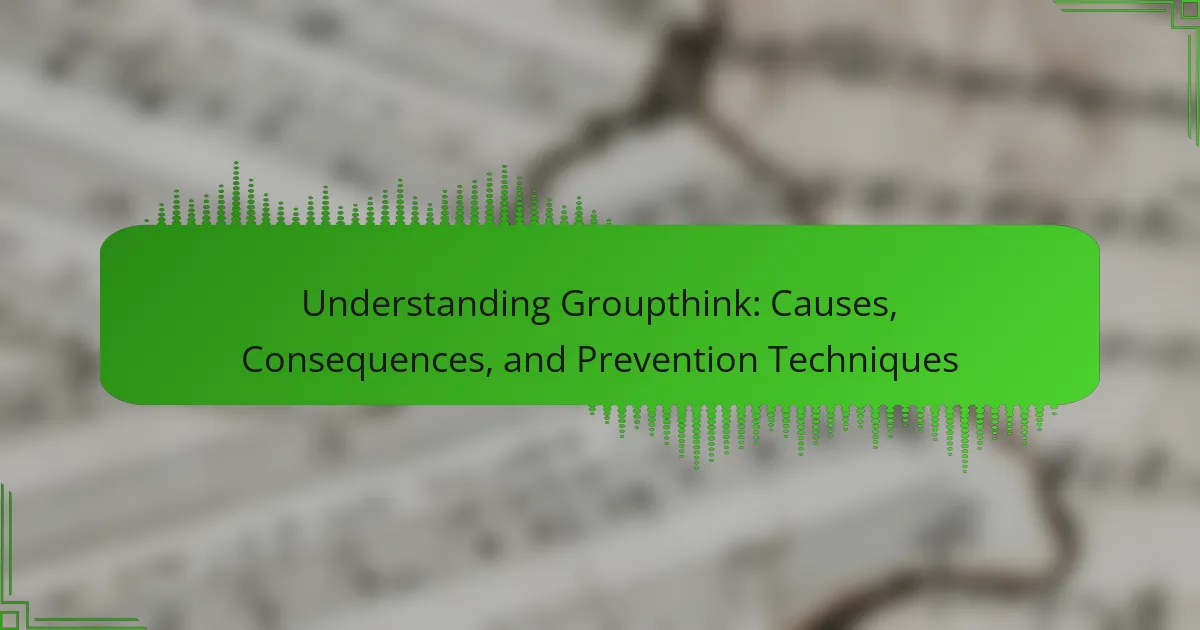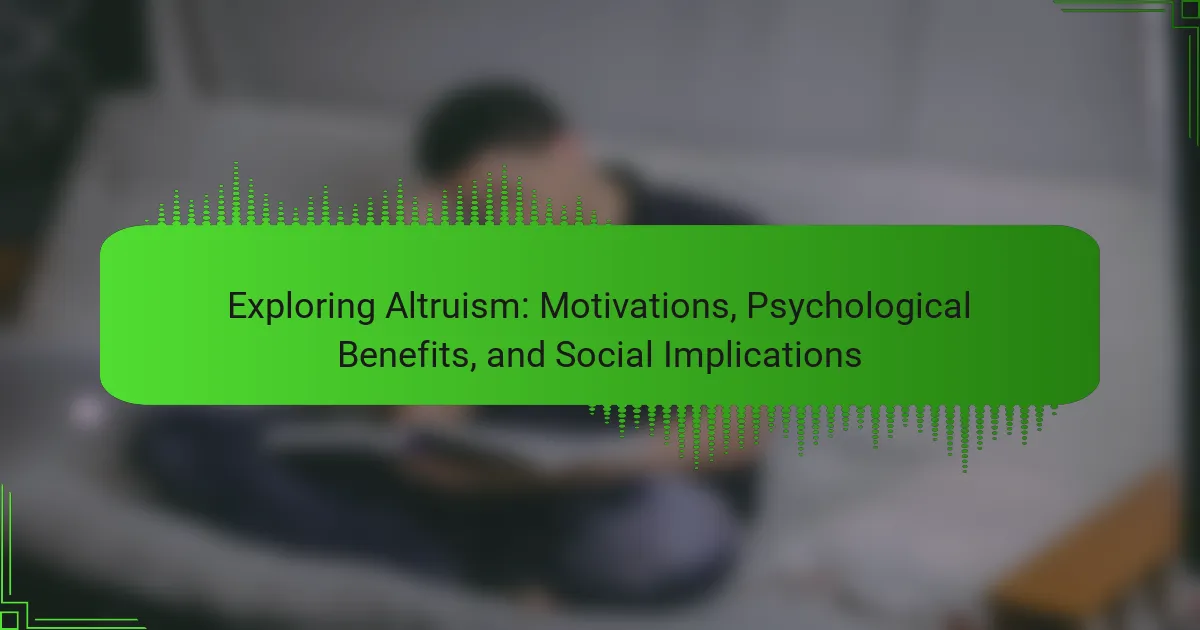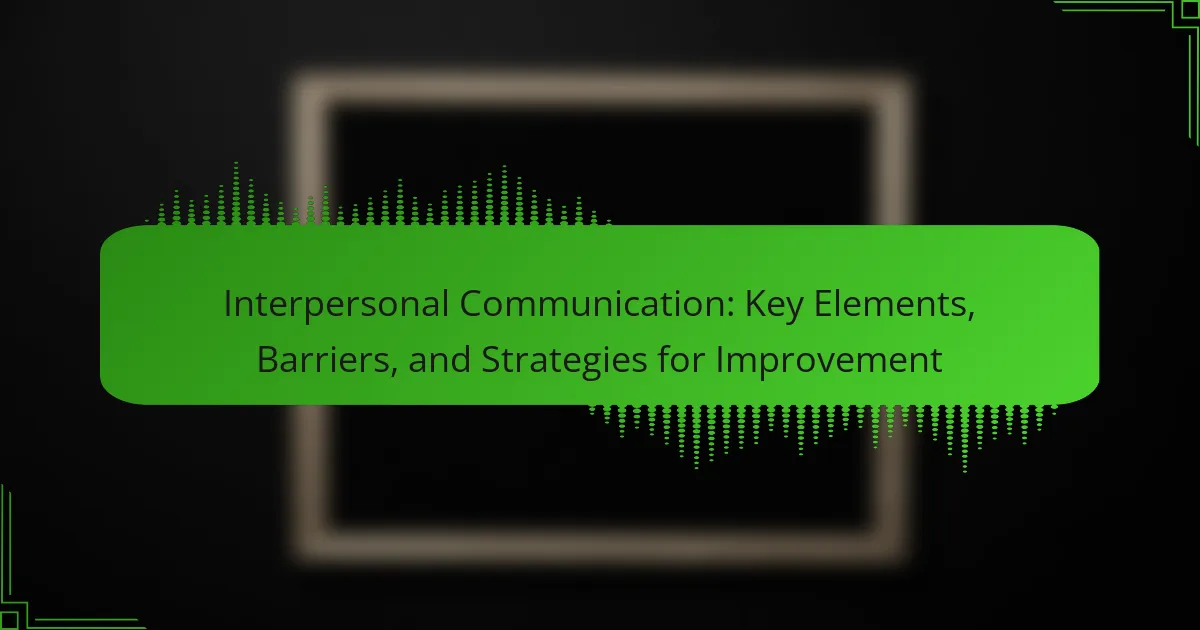Groupthink is a psychological phenomenon characterized by the suppression of dissenting viewpoints within a group, leading to irrational decision-making and a lack of critical evaluation. This article explores the causes of groupthink, including high cohesion, strong leadership, and isolation from external opinions, as well as its consequences, such as poor decisions and diminished innovation. Historical examples like the Bay of Pigs invasion and the Challenger disaster illustrate the dangers of groupthink. The article also outlines prevention techniques, emphasizing the importance of open dialogue, diverse perspectives, and structured decision-making processes to mitigate the risks associated with groupthink.

What is Groupthink?
Groupthink is a psychological phenomenon where the desire for harmony in a group leads to irrational decision-making. It occurs when group members suppress dissenting viewpoints to maintain consensus. This results in a lack of critical evaluation of alternatives. Groupthink can lead to poor decisions and outcomes. Historical examples include the Bay of Pigs invasion and the Challenger disaster. In these cases, group cohesion overshadowed realistic assessments of risks. Groupthink can be mitigated by encouraging open dialogue and inviting external opinions.
How does Groupthink manifest in decision-making processes?
Groupthink manifests in decision-making processes through a tendency for group members to prioritize consensus over critical analysis. This phenomenon leads to a lack of diverse viewpoints. Members may suppress dissenting opinions to maintain harmony. They often overlook alternative solutions and fail to evaluate risks adequately. Historical examples, such as the Bay of Pigs invasion, illustrate the consequences of groupthink. In that case, decision-makers ignored warnings and alternative strategies. Research shows that cohesive groups can become insulated from outside opinions. This isolation further exacerbates the problem, resulting in poor decision outcomes.
What are the key characteristics of Groupthink?
Groupthink is a psychological phenomenon that occurs within a group. It leads to poor decision-making due to a desire for harmony. Key characteristics include a strong sense of invulnerability among members. This can result in overconfidence and risk-taking behaviors. Another characteristic is the suppression of dissenting viewpoints. Members may feel pressured to conform to the majority opinion. There is also an illusion of unanimity, where silence is perceived as agreement. Additionally, groupthink fosters the belief in the inherent morality of the group. This can diminish critical evaluation of alternative actions. These characteristics can lead to flawed decisions, as seen in historical events like the Bay of Pigs invasion.
How does Groupthink affect group dynamics?
Groupthink negatively affects group dynamics by promoting conformity over critical thinking. Members may suppress dissenting opinions to maintain harmony. This leads to poor decision-making and a lack of creativity. Research shows that groupthink can result in missed opportunities and flawed solutions. For example, the Bay of Pigs invasion is a historical case where groupthink led to disastrous outcomes. In such scenarios, individuals prioritize consensus rather than evaluating alternatives. Consequently, group effectiveness diminishes, and innovation is stifled. Overall, groupthink undermines the collaborative potential of teams.
Why is understanding Groupthink important?
Understanding Groupthink is important because it can lead to poor decision-making in groups. Groupthink occurs when the desire for harmony or conformity results in irrational or dysfunctional outcomes. This phenomenon can suppress dissenting viewpoints and limit critical thinking. Research indicates that groupthink can contribute to major failures, such as the Challenger Space Shuttle disaster in 1986. In that case, key concerns were ignored due to pressure for consensus. Recognizing groupthink helps organizations foster open communication. It encourages diverse opinions and improves decision-making processes. Understanding groupthink ultimately enhances group effectiveness and reduces the risk of costly mistakes.
What are the implications of Groupthink in organizational settings?
Groupthink in organizational settings leads to poor decision-making and stifles innovation. It occurs when a group prioritizes consensus over critical analysis. This can result in overlooking alternative solutions. Group members may suppress dissenting opinions to maintain harmony. Consequently, organizations may face negative outcomes, such as failed projects or missed opportunities. Research by Janis (1972) indicates that groupthink can lead to disastrous decisions, as seen in historical events like the Bay of Pigs invasion. Therefore, recognizing and addressing groupthink is essential for effective organizational functioning.
How can Groupthink impact creativity and innovation?
Groupthink negatively impacts creativity and innovation by suppressing individual ideas. It fosters a desire for consensus over critical thinking. Members may avoid expressing dissenting opinions to maintain harmony. This leads to a lack of diverse perspectives. Research shows that teams experiencing groupthink produce fewer innovative solutions. A study by Janis (1972) highlighted that such groups often overlook alternative approaches. Consequently, creativity suffers as unique contributions are stifled. Ultimately, groupthink can result in poor decision-making and missed opportunities for innovation.

What causes Groupthink?
Groupthink is caused by a desire for harmony and conformity within a group. This leads to the suppression of dissenting viewpoints. Factors contributing to groupthink include high group cohesion, strong leadership, and isolation from outside opinions. When members prioritize consensus over critical evaluation, they may overlook alternative solutions. Additionally, time pressure can exacerbate this tendency. Research shows that groups with a strong desire for unanimity are more prone to groupthink. Historical examples, such as the Bay of Pigs invasion, illustrate the dangers of this phenomenon.
What psychological factors contribute to Groupthink?
Groupthink is influenced by several psychological factors. These factors include conformity pressure, which compels individuals to align their opinions with the group. Members often fear social rejection or conflict, leading to a suppression of dissenting views. Illusion of invulnerability can arise, fostering overconfidence in the group’s decisions. Collective rationalization occurs when members dismiss warnings or negative feedback. Additionally, group cohesion can create an environment where critical thinking is stifled. The desire for unanimity often outweighs the need for realistic appraisal of alternatives. Research shows that these psychological factors can lead to poor decision-making and negative outcomes in group settings.
How does conformity influence Groupthink?
Conformity significantly influences Groupthink by promoting consensus over critical analysis. When individuals conform, they prioritize group harmony and agreement. This leads to the suppression of dissenting opinions. Group members may ignore alternative viewpoints to avoid conflict. Research shows that high conformity can diminish the quality of decision-making. A study by Janis (1972) highlighted that cohesive groups often overlook potential risks. This dynamic fosters an environment where poor decisions can prevail. Ultimately, conformity can undermine the group’s ability to evaluate options effectively.
What role does group cohesion play in fostering Groupthink?
Group cohesion significantly contributes to fostering Groupthink. High levels of cohesion can lead to a strong desire for consensus among group members. This desire often results in the suppression of dissenting opinions. Members may prioritize harmony over critical evaluation of ideas. Consequently, this can hinder effective decision-making processes. Research indicates that cohesive groups are more susceptible to Groupthink. A study by Janis (1972) highlights that cohesive teams often overlook warning signs and alternative viewpoints. This dynamic can ultimately lead to poor outcomes and flawed decisions.
What external factors can lead to Groupthink?
External factors that can lead to Groupthink include high levels of stress and time pressure. When groups face tight deadlines, they may prioritize quick decisions over critical evaluation. This urgency can suppress dissent and promote conformity. Additionally, strong group cohesion can contribute to Groupthink. When members feel a strong bond, they may avoid conflict to maintain harmony. Leadership style also plays a role. Authoritarian leaders can stifle alternative viewpoints, leading to unchallenged consensus. Furthermore, external threats can heighten anxiety within a group. This anxiety can push members towards a unified decision, disregarding individual opinions. Overall, these external factors create an environment where critical thinking is diminished.
How do leadership styles affect the likelihood of Groupthink?
Leadership styles significantly influence the likelihood of Groupthink. Authoritarian leadership often promotes conformity and suppresses dissenting opinions. This environment increases the risk of Groupthink, as members may hesitate to voice contrary views. In contrast, democratic leadership encourages open dialogue and diverse perspectives. This approach reduces the chances of Groupthink by fostering critical thinking and constructive debate. Research indicates that teams led by transformational leaders experience lower Groupthink levels. Transformational leaders inspire innovation and challenge the status quo, which mitigates conformity pressures. Thus, leadership styles play a crucial role in determining the susceptibility of groups to Groupthink.
What environmental pressures may encourage Groupthink?
Environmental pressures that may encourage Groupthink include high stress, time constraints, and a strong desire for consensus. High stress can lead to rushed decision-making, reducing critical thinking. Time constraints often force teams to prioritize speed over thorough analysis. A strong desire for consensus can suppress dissenting opinions, creating an illusion of agreement. Additionally, a cohesive group identity can discourage individuals from voicing alternative viewpoints. Research indicates that these pressures contribute to a lack of diverse perspectives, which is crucial for effective decision-making.

What are the consequences of Groupthink?
Groupthink leads to poor decision-making and a lack of critical thinking. It often results in the suppression of dissenting viewpoints. This can cause teams to overlook important information. Groupthink may also lead to a false sense of consensus. Teams may become overly confident in their decisions. This can result in failed projects or initiatives. Historical examples include the Bay of Pigs invasion, which suffered from groupthink. Research shows that groupthink can diminish innovation and creativity. These consequences highlight the importance of encouraging diverse opinions in decision-making processes.
How does Groupthink affect decision quality?
Groupthink negatively affects decision quality by promoting conformity over critical analysis. This phenomenon leads to poor decision-making outcomes. Members prioritize consensus and harmony instead of evaluating alternatives. As a result, crucial information may be overlooked. Research by Janis (1972) highlights that groupthink can suppress dissenting opinions. This suppression reduces the diversity of perspectives necessary for sound decisions. Groups experiencing this often fail to consider risks adequately. Ultimately, the quality of decisions suffers due to a lack of thorough evaluation.
What are some real-world examples of poor decisions caused by Groupthink?
Some real-world examples of poor decisions caused by Groupthink include the Bay of Pigs invasion and the Challenger disaster. The Bay of Pigs invasion in 1961 involved a failed attempt by U.S. forces to overthrow Fidel Castro in Cuba. Groupthink led to a lack of dissenting opinions and critical analysis of the plan. This resulted in a poorly executed operation and significant embarrassment for the U.S. government.
The Challenger disaster in 1986 involved the explosion of the Space Shuttle Challenger shortly after launch. Engineers raised concerns about the O-rings in cold weather. However, group pressure led to the decision to proceed with the launch despite these warnings. This tragic event resulted in the loss of seven astronauts and highlighted the dangers of ignoring dissent in decision-making processes.
Both instances demonstrate how Groupthink can suppress critical thinking and lead to catastrophic outcomes.
How can Groupthink lead to ethical lapses in organizations?
Groupthink can lead to ethical lapses in organizations by suppressing dissenting opinions. When team members prioritize harmony over critical evaluation, they may ignore ethical concerns. This phenomenon often results in poor decision-making. The desire for consensus can create a false sense of security. Members may feel pressured to conform, leading to compromised moral standards. Historical examples, such as the Challenger disaster, illustrate these risks. In that case, engineers raised concerns, but groupthink silenced them, resulting in tragedy. Thus, groupthink undermines ethical considerations and fosters an environment for lapses.
What are the long-term impacts of Groupthink on organizations?
Groupthink leads to poor decision-making in organizations over the long term. It fosters conformity and discourages dissenting opinions. This results in a lack of critical thinking and innovation. Organizations may miss out on valuable insights and alternative solutions. Groupthink can also create a culture of fear, where employees hesitate to voice concerns. This can lead to decreased morale and job satisfaction. Long-term reliance on groupthink may result in significant strategic failures. Historical examples, such as the Bay of Pigs Invasion, illustrate the detrimental effects of groupthink on organizational outcomes.
How can Groupthink affect organizational culture?
Groupthink can negatively impact organizational culture by stifling creativity and critical thinking. It occurs when a group prioritizes consensus over individual opinions. This leads to poor decision-making and a lack of diverse perspectives. Employees may feel pressured to conform, reducing their willingness to express dissenting views. As a result, innovation may decline, and the organization may fail to adapt to changing environments. Historical examples, such as the Bay of Pigs invasion, illustrate how groupthink can lead to disastrous outcomes. Cultivating an open culture that encourages debate can mitigate these effects.
What risks does Groupthink pose to organizational reputation?
Groupthink poses significant risks to organizational reputation. It can lead to poor decision-making due to a lack of diverse perspectives. This conformity can result in unethical practices being overlooked. Such decisions may harm stakeholders and diminish trust. A notable example is the Enron scandal, where groupthink contributed to widespread corporate fraud. The resulting loss of public trust severely damaged Enron’s reputation. Additionally, organizations may face backlash from consumers and investors if failures are linked to groupthink. This can lead to decreased market value and long-term financial consequences.

How can Groupthink be prevented?
Groupthink can be prevented by encouraging open dialogue and critical thinking. Leaders should promote a culture where dissenting opinions are valued. This can involve assigning a “devil’s advocate” to challenge ideas. Regularly seeking anonymous feedback can also help surface hidden concerns. Diverse team composition can bring different perspectives, reducing conformity pressure. Structured decision-making processes can guide teams to consider alternatives thoroughly. Training in conflict resolution can equip members to handle disagreements constructively. Research shows that these strategies significantly reduce the likelihood of groupthink occurring.
What strategies can organizations implement to avoid Groupthink?
Organizations can implement several strategies to avoid Groupthink. Encouraging open communication is crucial. This allows team members to express dissenting opinions without fear. Appointing a devil’s advocate can stimulate critical thinking. This role challenges ideas and promotes diverse viewpoints. Conducting anonymous feedback sessions can also help. It enables honest input without group pressure. Additionally, fostering a culture of inclusivity is essential. This ensures all voices are heard and valued. Regularly revisiting decisions can mitigate premature consensus. This practice allows for reassessment and adjustment of ideas. Training on recognizing Groupthink can enhance awareness. Educating teams on its signs helps prevent its occurrence. These strategies collectively create an environment that supports diverse perspectives.
How can promoting open dialogue mitigate Groupthink?
Promoting open dialogue mitigates Groupthink by encouraging diverse perspectives. It allows team members to express differing opinions without fear. This process fosters critical thinking and reduces conformity pressure. Research shows that teams engaging in open discussions make better decisions. A study by Janis (1972) highlights that open communication leads to more thorough evaluations of alternatives. Therefore, creating an environment for dialogue is essential for effective decision-making.
What role does diversity play in preventing Groupthink?
Diversity plays a crucial role in preventing Groupthink by introducing varied perspectives and ideas. When a group consists of individuals from different backgrounds, they bring unique experiences and viewpoints. This variety encourages critical thinking and open discussion. Research shows that diverse teams are more innovative and make better decisions. A study published in the Harvard Business Review found that diverse teams outperform homogeneous ones in problem-solving. By challenging assumptions and stimulating debate, diversity mitigates the risks associated with Groupthink. It creates an environment where dissent is valued, leading to more thorough evaluations of options.
What are some practical techniques for leaders to combat Groupthink?
Encouraging open dialogue is a practical technique for leaders to combat Groupthink. Leaders should create an environment where team members feel safe to express dissenting opinions. Implementing anonymous feedback mechanisms can also help. This allows individuals to voice concerns without fear of repercussions. Assigning a “devil’s advocate” role challenges prevailing viewpoints. It promotes critical thinking and prevents premature consensus. Regularly seeking outside opinions can provide fresh perspectives. This approach helps to identify blind spots within the group. Conducting structured decision-making processes reduces the risk of Groupthink. These techniques have been shown to enhance group effectiveness and decision quality.
How can leaders encourage dissenting opinions?
Leaders can encourage dissenting opinions by creating a safe environment for open dialogue. This can be achieved by actively soliciting feedback from team members. Leaders should express appreciation for diverse viewpoints. They must ensure that all voices are heard during discussions. Establishing ground rules that promote respectful disagreement is essential. Regularly holding brainstorming sessions can facilitate this process. Encouraging anonymous feedback can also help in voicing dissent without fear. Research shows that diverse perspectives enhance decision-making quality, as indicated by a study from the Harvard Business Review.
What tools can be used to facilitate better decision-making processes?
Decision-making processes can be facilitated by various tools. These tools include decision matrices, brainstorming software, and mind mapping applications. Decision matrices help evaluate options based on specific criteria. Brainstorming software encourages idea generation and collaboration among team members. Mind mapping applications visually organize thoughts and concepts, aiding clarity. Additionally, project management tools help track decisions and their outcomes. Surveys and feedback tools gather input from stakeholders, enhancing inclusiveness. These tools have been shown to improve outcomes by promoting structured thinking and collaboration.
What are some best practices for teams to reduce the risk of Groupthink?
Encouraging open dialogue is a best practice for teams to reduce the risk of Groupthink. This involves creating an environment where all team members feel safe to express their opinions. Facilitating anonymous feedback can also help gather diverse perspectives. Assigning a devil’s advocate role during discussions challenges prevailing viewpoints. Regularly seeking input from external experts introduces new ideas and reduces insularity. Implementing structured decision-making processes ensures thorough evaluation of options. Lastly, promoting a culture of critical thinking encourages team members to question assumptions and explore alternatives. These practices collectively foster a more inclusive and thoughtful decision-making environment.
How can regular feedback loops help in minimizing Groupthink?
Regular feedback loops can help minimize Groupthink by promoting open communication and diverse perspectives. They encourage team members to express differing opinions without fear of reprisal. This process allows for critical evaluation of ideas, reducing the likelihood of consensus without discussion. Research shows that teams with regular feedback mechanisms are more likely to identify potential flaws in group decisions. A study published in the Journal of Organizational Behavior found that feedback fosters a culture of psychological safety, which is essential for healthy team dynamics. By integrating regular feedback, organizations can enhance decision-making quality and decrease the risks associated with Groupthink.
What training can teams undergo to recognize and address Groupthink?
Teams can undergo training focused on critical thinking and decision-making processes to recognize and address Groupthink. This training includes workshops that promote open dialogue and encourage diverse viewpoints. Role-playing scenarios can help team members practice challenging assumptions constructively. Facilitated discussions can create a safe environment for expressing dissenting opinions. Training can also involve case studies analyzing past instances of Groupthink in organizations. By examining these cases, teams can identify warning signs and learn effective intervention strategies. Research indicates that structured decision-making techniques reduce the likelihood of Groupthink. Implementing these training methods fosters a culture of critical evaluation and enhances team performance.
Groupthink is a psychological phenomenon characterized by the desire for group harmony, leading to irrational decision-making and the suppression of dissenting viewpoints. This article explores the causes of groupthink, including high cohesion and conformity pressures, and outlines its consequences, such as poor decision quality and missed opportunities for innovation. Historical examples, like the Bay of Pigs invasion and the Challenger disaster, illustrate the dangers of groupthink in organizational settings. The article also provides prevention techniques, emphasizing the importance of open dialogue, diverse perspectives, and structured decision-making processes to mitigate the risks associated with groupthink.



